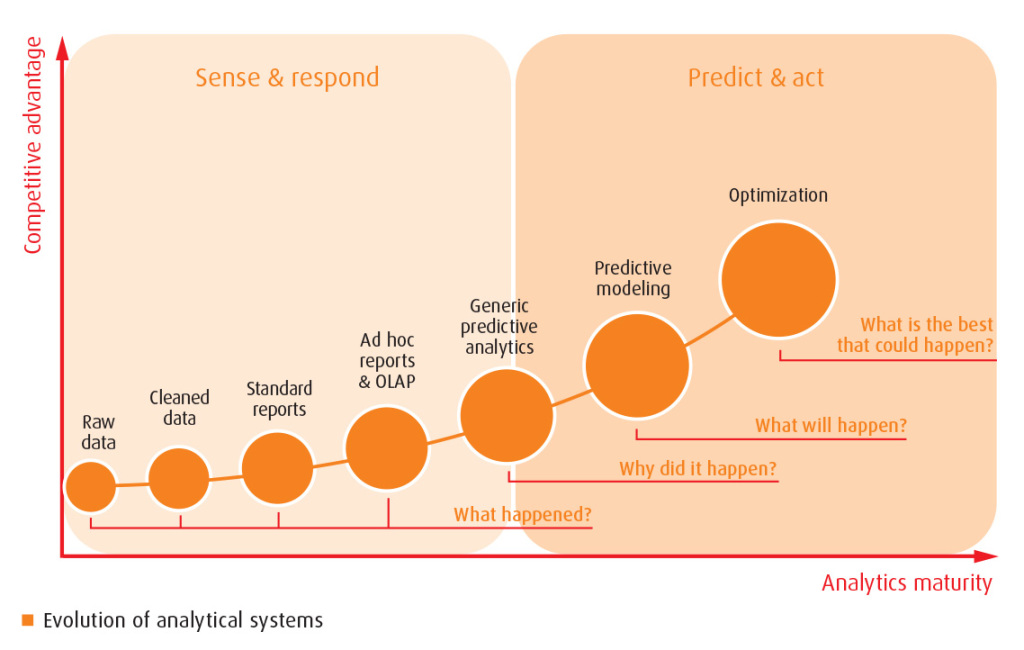We live in a reality in which terabytes of data are commonplace. It is worth considering this phenomenon, not as a problem but rather as a challenge that must be addressed in order to make optimum use of the opportunities offered by access to a huge wealth of knowledge. More than ever companies need to acquire the capacity to respond to the evolving market conditions. Understanding the processes of change and the effective preparation for these changes is a prerequisite for maintaining a competitive advantage. The ability to answer the question “what will happen?" is no longer the domain of divination, but it is becoming a business necessity.
What will happen?
However, from an analytical point of view, most organizations are still only able to say “what happened?” This applies in particular to the existing SAP customers, who used SAP Business Intelligence tools and did not have other similar SAP tools, and rarely choose to additionally purchase specialized tools for statistical and predictive modelling from external vendors.
The solutions to perform predictive analyses differ from traditional Business Intelligence tools. Their main task, rather than access to standard reports on sales or inventory data, is business data mining and modelling, searching for trends and correlations that will allow to predict future events, customer behaviour, or other interesting facts.
The predictive analysis is also a natural step in the further evolution of analytical systems. Companies that have been already using advanced data analysis, drilling and visualization features can make even better use of the knowledge hidden in the data with the help of more and more common and important data analytics. In particular, this becomes a necessity with the advent of the Big Data era and real-time analysis, which is possible due to in-memory solutions such as SAP HANA.
Predictive analyses in SAP
We have good news for those customers who have waited for a specific strategy in this area from SAP. More recently SAP has been offering the SAP Business Objects Predictive Analysis tool which is competitive to the existing market leaders such as SAS or SPSS. The tool can be deployed as a standalone solution or in conjunction with other SAP solutions, including the SAP HANA platform, which allows running even wider and faster trend forecasting capabilities.
SAP BusinessObjects Predictive Analysis includes a wide range of ready-made algorithms and with the support for the R language; a widely recognized open standard language used for statistical analysis allows you to define your own models.
The solution is available as a separate tool and as an integrated analytical tool with the in-memory SAP HANA database which has a built-in library of statistical functions.
The tool itself is easy to use and provides powerful and attractive visualization of mined data. All the data access, selection, preparation and processing functions are available in a modern graphical environment using the “drag and drop" functionality. The results of analyses can be transferred to other SAP Business Intelligence applications, mobile devices, or Microsoft Office.
What distinguishes SAP Predictive Analysis from similar tools available on the market is its openness to business.
Today, in those organizations that are already using specialized statistical and data mining tools, the predictive analyses are conducted by statisticians and mathematicians who generate numbers that are rarely visualized and communicated in the accessible and comprehensible form to business users. Such tools are considered powerful expert tools that do not allow useful predictive analyses to be carried out by business and for business.
In this sense, SAP Predictive Analysis is a unique tool. Its designers were guided by the primary idea of making it principally useful in business development.

Business benefits
SAP Predictive Analysis allows business users to quickly and easily discover patterns and to predict results without the need to involve IT and statisticians in this process. This tool allows you to intuitively design complex activity forecasting models, allowing to:
- predict market trends and customer requirements,
- predict how price fluctuations will affect costs and requirements,
- see how changes in the supply of various products will affect the whole supply chain,
- understand what factors most strongly influence sales, demand and production,
- optimally adapt product offering and service level to the expectations of every customer,
- identify trends in financial liquidity to manage your business more effectively,
- understand consumer sentiment.
Such analyses can be applied to any business scenario, allowing companies to significantly increase the ability to respond to rapidly changing market conditions, and thereby gaining a competitive advantage. The predictive capabilities of the tool can be used in many areas of the company associated with intensive use of large amounts of data, such as sales, marketing, risk analysis, corporate governance and security management.
The SAP Predictive Analysis application can easily be incorporated into the existing BI landscape. It requires the minimum configuration and is easy to use, enabling business users to quickly and intuitively take advantage of its capabilities.
Popular trends
The predictive analytics is perceived as a natural step in the development of Business Intelligence systems. With the development of technology, and in an era of increasingly easier and cheaper access to large amounts of information, the tools to analyse and predict trends are becoming more common. However, it is not fashion, but a real need to quickly adapt to the changing business and environment, which is an impulse to begin analyses to find trends and predict changes. SAP’s answer to these needs is the SAP Predictive Analysis.

